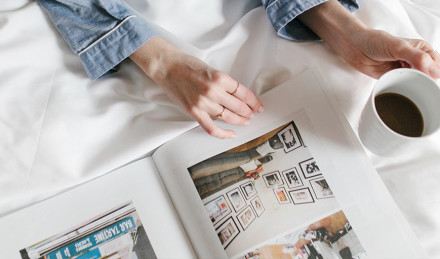Some might say there are two types of flyers in the world: Those who can sleep on a plane and those who can’t. While most of us are probably somewhere in the middle – let’s be real, no one actually sleeps well on a plane – there are certain things you can do to up the chances of getting some solid shuteye on your next flight.
Seat Yourself for Success
Most will agree that the highly coveted exit row window seat – preferably on an empty flight where you can get the whole row to yourself – is the holy grail of coach seating. But since we can’t all be that lucky, there are other ways to optimize your seat assignment.
Take a look at your plane’s layout (now’s the time to get familiar with seatguru.com if you’re not already – enter your flight number and get all sorts of insider information about where to sit). Try to avoid seats near the restrooms, where there’s likely to be more commotion and noise. Same goes for the rows in the front of the plane near the flight attendants’ station. You’ll also want to avoid the very back row, as often those seats don’t recline. Some travelers prefer a spot near the wings, where the engine hum creates a silencing, white-noise effect that helps block out other sounds.
Seat Yourself for Success
Most will agree that the highly coveted exit row window seat – preferably on an empty flight where you can get the whole row to yourself – is the holy grail of coach seating. But since we can’t all be that lucky, there are other ways to optimize your seat assignment.
Take a look at your plane’s layout (now’s the time to get familiar with seatguru.com if you’re not already – enter your flight number and get all sorts of insider information about where to sit). Try to avoid seats near the restrooms, where there’s likely to be more commotion and noise. Same goes for the rows in the front of the plane near the flight attendants’ station. You’ll also want to avoid the very back row, as often those seats don’t recline. Some travelers prefer a spot near the wings, where the engine hum creates a silencing, white-noise effect that helps block out other sounds.
Find the Support You Need
Even if you’re stuck with a less than optimal seat assignment, you can still maximize your comfort by supporting your neck and your back. First, flip around that doughnut pillow you’ve been using and wear it backwards, so it wraps around the front. This better supports your neck and head, providing a stabilizing effect in every direction. Second, don’t be afraid to recline. We realize this might violate some people’s Traveler’s Code of Conduct, but sitting straight up causes stress on your lower back, as does leaning forward (tray sleepers, we’re talking to you). The more you can recline, the less pressure you place on your spine. If you’re worried about committing a flying faux-pas, here’s a good rule of thumb to follow:
If the cabin lights are dimmed, it means passengers are expected to sleep, so reclining is generally more acceptable (and there’s a good chance the person behind you is leaned back, too).
Now, once you’re reclined, stretch out your legs and notice the space between your lower back and the seat. Filling that will help you stay comfortable. Some travelers bring a special, wedge-shaped pillow to accomplish this task, but you can just as easily use an extra blanket or balled-up sweater.
Find the Support You Need
Even if you’re stuck with a less than optimal seat assignment, you can still maximize your comfort by supporting your neck and your back. First, flip around that doughnut pillow you’ve been using and wear it backwards, so it wraps around the front. This better supports your neck and head, providing a stabilizing effect in every direction. Second, don’t be afraid to recline. We realize this might violate some people’s Traveler’s Code of Conduct, but sitting straight up causes stress on your lower back, as does leaning forward (tray sleepers, we’re talking to you). The more you can recline, the less pressure you place on your spine. If you’re worried about committing a flying faux-pas, here’s a good rule of thumb to follow:
If the cabin lights are dimmed, it means passengers are expected to sleep, so reclining is generally more acceptable (and there’s a good chance the person behind you is leaned back, too).
Now, once you’re reclined, stretch out your legs and notice the space between your lower back and the seat. Filling that will help you stay comfortable. Some travelers bring a special, wedge-shaped pillow to accomplish this task, but you can just as easily use an extra blanket or balled-up sweater.
Dress the Part and Accessorize Well
Like anywhere else, the more comfortable you are, the better you’ll sleep. You’ll want to keep your outfit warm and comfortable. Layering up will help ensure you’re the right temperature, and extra clothes, like a soft wrap or cozy sweater, can do double-duty as a support pillow or blanket. Generally, keep your clothing loose, except for the legs, that is — a pair of compression socks that reach over your shins will help improve circulation during long flights (and help prevent waking up to the feeling of pins and needles in your legs).
Many airlines only provide blankets or pillows on certain flights (and their sanitation is questionable), so do yourself a favor and bring your own. Try a soft, luxurious fabric like cashmere or a Merino Travel Kit to provide an extra level of comfort. Just be sure to buckle your seatbelt on the outside of your blanket to let the flight attendant know you’re following the rules. Don’t forget an eye mask to block out the light, too.
Dress the Part and Accessorize Well
Like anywhere else, the more comfortable you are, the better you’ll sleep. You’ll want to keep your outfit warm and comfortable. Layering up will help ensure you’re the right temperature, and extra clothes, like a soft wrap or cozy sweater, can do double-duty as a support pillow or blanket. Generally, keep your clothing loose, except for the legs, that is — a pair of compression socks that reach over your shins will help improve circulation during long flights (and help prevent waking up to the feeling of pins and needles in your legs).
Many airlines only provide blankets or pillows on certain flights (and their sanitation is questionable), so do yourself a favor and bring your own. Try a soft, luxurious fabric like cashmere or a Merino Travel Kit to provide an extra level of comfort. Just be sure to buckle your seatbelt on the outside of your blanket to let the flight attendant know you’re following the rules. Don’t forget an eye mask to block out the light, too.
Eat Smart
And just like life on land, what you eat will affect how you sleep in the sky. Avoid caffeine, sugar and alcohol prior to and during your flight. While you might think a few glasses of red wine will lull you off to la la land, combining alcohol with dry cabin air equals nothing but poor sleep and a possible hangover when you land.
Eat Smart
And just like life on land, what you eat will affect how you sleep in the sky. Avoid caffeine, sugar and alcohol prior to and during your flight. While you might think a few glasses of red wine will lull you off to la la land, combining alcohol with dry cabin air equals nothing but poor sleep and a possible hangover when you land.




